purpose: draft a document for the provost to plan for charting the future goal 3.12 “develop a comprehensive strategy to increase awareness and development of e-textbooks and open educational resources (OERs)”
\\STCLOUDSTATE\HuskyNet\DeptFiles\LRS\ETextbooks
SCSU goal: to reduce the cost of textbooks as an affordable learning initiative. Amount of reduction is undetermined
my notes based on the material below:
- best, most applicable source for the purpose of this research: U of Alberta Committee’s notes on the learning environment:
http://www.governance.ualberta.ca/en/GeneralFacultiesCouncil/CommitteeontheLearningEnvironm/~/media/Governance/Documents/GO05/LEA/15-16/WEB/Item-4-eTextbook-Subcommittee-Report-CLE-TLAT.pdf
the Canadians are using (citing) Acker (Ohio) in their research.
- best, most applicable source in terms of the logistics on e-texbooks creation and its pedagogical argumentation is this document from New Zealand: https://akoaotearoa.ac.nz/download/ng/file/group-7/guidelines-for-developing-interactive-etextbooks-on-net-tablets.pdf
- According to Bossaler et al (2014), it might be worth considering that SCSU (MnSCU?) must go first through implementing of e-text[books] in courses first by using publisher materials and then by using “in-house” produce. At this point, SCSU does NOT have an aligned policy of integrating e-texts in courses across campus. Lack of such experience might make a strategy for adoption of e-textbooks much more complex and difficult to implement
- stats are colored in green for convenience. Stats regarding the increase in textbook costs are re-printed from author to author: e.g. Acker (2011, p. 42). Murey and Perez (2011, p. 49 (bottom) – 50 (up)) reports stats from 2009 and projections for 2013 regarding etexbook adotion. Same authors, p. 50 second paragraph reports good stats regarding texbooks’ price increase : US$1122 per year for textbooks in 2010.
- Wimmer at al (2014) presents a lucid graphic of the structure of the publishing process (see bottom of this blog entry for citation and perm link).
- Wimmer at al (2014) discusses copyright and permissions, which is of interest for this research (p. 85)
- regarding in-house creation of e-textbooks, see (Distance education, e-learning, education and training, 2015). It very much follow the example of SUNY, which Keith was laying out: a team of faculty charged with creation the e-textbook for mass consumption.
Besides the SUNY model Keith is envisioning for MnSCU (comparable), there is the option of clustering OER sources: e.g. NASTA as per Horejsi (2013), CourseSmart. FlatWorld Knowledge (Murrey and Perez, 2011) etc.
- Hamedi & Ezaleila (2015) present an entire etextbook program. Article has been ordered through ILL. Same with Joseph (2015).
- Open Educational Resources in Acker (2015, p. 44-47). Also in Murey and Perez (2011, p. 51).
Also in ICWL (Conference) (13th : 2014 : Tallinn, E., & Cao, Y. (2014): OpenDSA
- Different models of pricing also in Acker (2015, p. 48). Keith touched on that
- students learn equally well from etextbooks as from paper ones: Taylor (2011)
- pedagogy
responses from colleagues:
Scott Robison, sarobison@mail.plymouth.edu: sparc-liboer@arl.org listserv
Jeff Gallant, Jeff.Gallant@usg.edu: David Ernst with the U and Ashley Miller from Ohio State U: dernst@umn.edu. Ashley’s is miller.6275@osu.edu.
definition e-textbook and
an electronic version of a printed book that can be read on a computer or handheld device designed specifically for this purpose.
-
a dedicated device for reading electronic versions of printed books.
Definition of: e-book
my note: there is no good definition about e-textbook in terms of the complexity, which e-textbook on campus might involve.
Considering Wimmer et al (2014) account on their campus experience in publishing e-textbook, a textbook may involve an LMS (Canvas) and blog (WordPress). Per my proposal during the F2F meeting, and following Rachel’s suggestion about discrimination of the different types of e-textbooks, here is an outline of e-textbook definition:
*******************
working definition for e-textbook for the purposes of SCSU:
e-textbook is a compilation of textual, multimedia and interactive material, which can be viewed on various electronic devices. E-textbook can: 1. be purchased from a publisher; 2. compiled in HTML format on faculty or group web space; 3. compiled on the content module of LMS (BB, D2L, Canvas, Moodle, etc.) 4. compiled on LMS (BB, D2L, Canvas, Moodle, etc.) and including all interactive materials: e.g. hyperlinks to MediaSpace multimedia, quizzes, etc.; 5. compiled on special apps, such as iBook Author, eCub, Sigil.
*******************
e-book
(Electronic-BOOK) The electronic counterpart of a printed book, which can be viewed on a desktop computer, laptop, smartphone, tablet or e-book reader (e-reader). When traveling, a huge number of e-books can be stored in portable units, dramatically eliminating weight and volume compared to paper. Electronic bookmarks make referencing easier, and e-book readers may allow the user to annotate pages.
Although fiction and non-fiction books come in e-book formats, technical material is especially suited for e-book delivery because it can be searched. In addition, programming code examples can be copied, which is why CD-ROMs that contained examples or the entire text were often packaged inside technical paper books.
E-Book Formats
Wimmer, Morrow, & Weber: Collaboration in eTextbook Publishing
There are several e-book formats on the market, including EPUB, Mobipocket (PRC, MOBI), eReader (PDB), Kindle (AZW, KF8) and Apple iBook (EPUB variation). Many e-readers also accept generic formats, including Adobe PDF and plain text (TXT).
——————
Electronic Textbooks or Paper Textbooks: What Are Students Reading?
According to a United States Government report, textbook prices have increased at over twice the rate of inflation in the last couple of decades. According to another report, the average student spends between $700 and $1,000 per year on textbooks while the cost of e-textbooks can be as much as 50% lower than paper textbooks.
Oxford dictionary, an electronic book or e-book is “an electronic version of a printed book that can be read on a computer or handheld device designed specifically for this purpose.” An e-textbook is defined as an e-book used for instructional or educational purposes and often includes features such as bookmarking, searching, highlighting, and note-taking as well as built-in dictionaries and pronunciation guides, embedded video-clips, embedded hyperlinks, and animated graphics.
E-textbooks have moved from occasional usage to a mainstream technology on college campuses. According to the Association of American Publishers, sales of e-books hit over $90 million; this is up over 200% when compared to the same month the previous year. When the cost of textbooks and the availability of formats are considered, the use of an e-textbook in the classroom may be the reasonable choice.
—————–
A
digital textbook is a digital book or
e-book intended to serve as the text for a class. Digital textbooks may also be known as
e-textbooks or
e-texts. Digital textbooks are a major component of technology-based education reform. They may serve as the texts for a traditional face-to-face class, an online course or degree.
The concepts of
open access and
open source support the idea of
open textbooks, digital textbooks that are free (gratis) and easy to distribute, modify and update
https://en.wikipedia.org/wiki/Digital_textbook—————-
Exploring Students’ E-Textbook Practices in Higher Education
- Authors: by Aimee Denoyelles, John Raible and Ryan Seilhamer Published: Monday, July 6, 2015. Instructional Designers, University of Central Florida
According to the United States Government Accountability Office, prices have increased 82 percent from 2002 to 2012.3 This cost sometimes drives students to
delay or avoid purchasing textbooks. Digital materials such as e-textbooks may offer a more cost-effective alternative.
4 Also, the expectation for digital materials is gaining strength in the K–12 sector.
5 For example, Florida school districts set a goal to spend at
least half of classroom material funding on digital materials by the 2015–2016 school year. Given that 81 percent of first-time-in-college (FTIC) undergraduate students hailed from a Florida public high school during the fall 2014 semester at the University of Central Florida (UCF), it is important to anticipate student expectations of digital materials. Finally, the availability of digital materials has risen exponentially with the incredible popularity of mobile devices.
Key Issues
Despite the advantages that e-textbooks pose, such as interactive features and accessibility on mobile devices, several barriers exist regarding implementation in higher education, namely non-standardization of the platform, limited use by students, and the unclear role of the instructor in adoption.
a survey questionnaire in 2012 that explored basic usage and attitudes regarding e-textbooks.
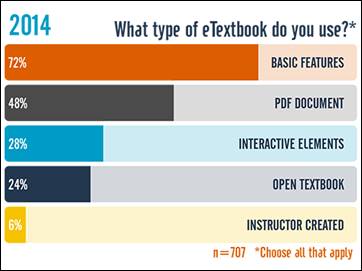


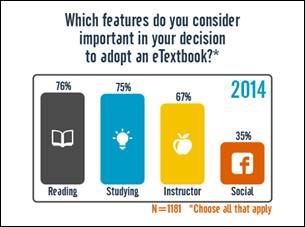

—————————–
Bossaller, J., & Kammer, J. (2014). Faculty Views on eTextbooks: A Narrative Study. College Teaching, 62(2), 68-75. doi:10.1080/87567555.2014.885877
http://login.libproxy.stcloudstate.edu/login?qurl=http%3a%2f%2fsearch.ebscohost.com%2flogin.aspx%3fdirect%3dtrue%26db%3dkeh%26AN%3d95094045%26site%3dehost-live%26scope%3dsite
Implementing eTexts into a Course:
- planning
- developing
- implementing
- delivering
This qualitative study gives insight into the experiences instructors have when working with publishers to integrate electronic content and technology into their courses.
Baek, E., & Monaghan, J. (2013). Journey to Textbook Affordability: An Investigation of Students’ Use of eTextbooks at Multiple Campuses. International Review Of Research In Open And Distance Learning, 14(3), 1-26.
http://eric.ed.gov/?id=EJ1017493
the Advisory Committee on Student Financial Assistance (2007) reported that textbook prices represent a significant barrier to students’ accessibility to textbooks. The report concluded that textbooks cost between $700-$1000 per year; textbook prices have risen much faster than other commodities; and that college aid fails to cover textbook expenses. Textbook costs are equivalent to 26% of tuition costs for an average four-year public university student and 72% of tuition costs for an average community college student. In fact, the California State Auditor (2008) reported that textbook costs grew more rapidly than student fees in academic year 2007–08.
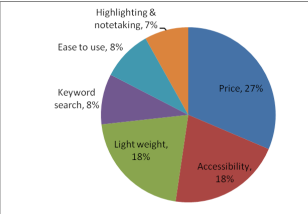
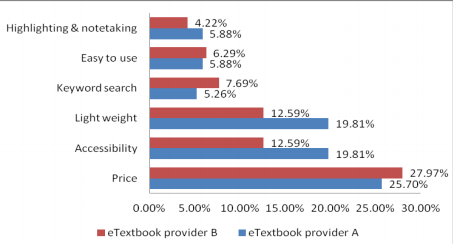
++++++++++++
Wimmer, E. e., Morrow, A. a., & Weber, A. a. (2014). Collaboration in eTextbook Publishing: A Case Study.Collaborative Librarianship, 6(2), 82-86.
http://login.libproxy.stcloudstate.edu/login?qurl=http%3a%2f%2fsearch.ebscohost.com%2flogin.aspx%3fdirect%3dtrue%26db%3dllf%26AN%3d108762075%26site%3dehost-live%26scope%3dsite
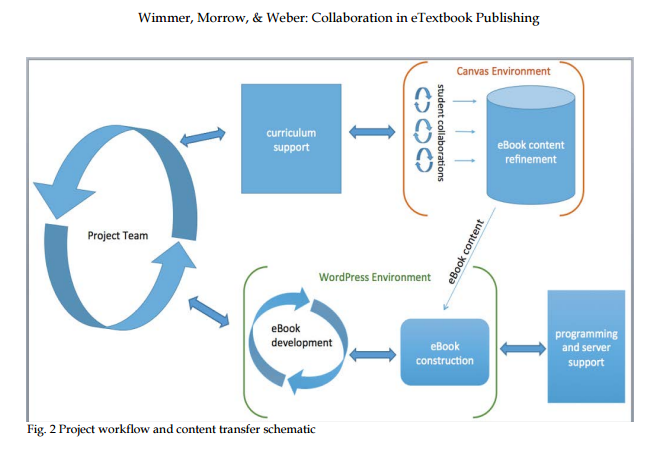
Distance education, e-learning, education and training. (2015). Clinical Chemistry & Laboratory Medicine, 53s557-s559. doi:10.1515/cclm-2015-5015
http://login.libproxy.stcloudstate.edu/login?qurl=http%3a%2f%2fsearch.ebscohost.com%2flogin.aspx%3fdirect%3dtrue%26db%3daph%26AN%3d102854748%26site%3dehost-live%26scope%3dsite
the creation of an interactive e-book called “Practical Clinical Chemistry: core concepts” was accomplished using the
Apple Macintosh platform and the iBooks Author software. Digital content, including videos, was developed for the
project and embedded within the final package. In order to limit the size of the final files, some content was uploaded
onto Youtube so that the user could access these via the internet.
The e-book, 200MB in size, was uploaded onto the Apple ITunes site and made available in 51 countries via the
iBooks store. This prototype is the first interactive digital textbook available in clinical chemistry and contains “4-
dimensional” content including digital images, videos, interactive presentations, real-time data generation as well as
review questions with instant feedback and assessment.
Hamedi, M., & Ezaleila, S. (2015). Digital Textbook Program in Malaysia: Lessons from South Korea. Publishing Research Quarterly, 31(4), 244-257. doi:10.1007/s12109-015-9425-4
Joseph, R. (2015). Higher Education Book Publishing-from Print to Digital: A Review of the Literature. Publishing Research Quarterly, 31(4), 264-274. doi:10.1007/s12109-015-9429-0
the author reflects the process on a state level (Ohio).
Marcoux, E. “. (2012). Best of the Best Planning. Teacher Librarian, 39(4), 69-70.
Taylor, A. K. (2011). Students Learn Equally Well From Digital as From Paperbound Texts. Teaching Of Psychology, 38(4), 278-281. doi:10.1177/0098628311421330
Much of the research related to digital texts has focused ontechnical aspects of readability (see Dillon, 1992, for a review) and limitations of digital media for note-taking, underlining, or highlighting text (Brown, 2001). However, the important—and unanswered—question from a teaching perspective is, ‘‘Can students learn as well from digital texts as from paperbound textbooks?’’ Few published studies have addressed this ques-tion directly, and even fewer studies have examined this ques-tion among college students.
Murray, M. C., & Pérez, J. (2011). E-Textbooks Are Coming: Are We Ready?. Issues In Informing Science & Information Technology, 849-60.
read the entire article, good data.
CourseSmart. FlatWorld Knowledge,
Horejsi, M. (2014). Textbooks 2.0. Science Teacher, 81(3), 8. http://login.libproxy.stcloudstate.edu/login?qurl=http%3a%2f%2fsearch.ebscohost.com%2flogin.aspx%3fdirect%3dtrue%26db%3daph%26AN%3d94603788%26site%3dehost-live%26scope%3dsite
++++++++++++++
pedagogy
two Eastern Europeans (Moldova, Serbia) raise serious concerns about electronic textbooks
Španović, S. (2010). PEDAGOGICAL ASPECTS OF E-TEXTBOOKS. Odgojne znanosti. 12(2). 459-470.
Railean, E. (2015). https://prezi.com/sbidiadctrzo/beyond-textbook-digital-textbook-use-and-development/
http://www.governance.ualberta.ca/en/GeneralFacultiesCouncil/CommitteeontheLearningEnvironm/~/media/Governance/Documents/GO05/LEA/15-16/WEB/Item-4-eTextbook-Subcommittee-Report-CLE-TLAT.pdf :
- (Un)desirable features in etextbooks
- How etextbooks might affect course delivery
- Pilot projects that can help build institutional expertise
- Address how and where insights gained from pilot projects will be collected and
- made available
- People resources (e.g., instructional designers) that will be needed to assist
- instructors to use this technology
ICWL (Conference) (13th : 2014 : Tallinn, E., & Cao, Y. (2014). New horizons in web based learning: ICWL 2014 international workshops, SPeL, PRASAE, IWMPL, OBIE, and KMEL, FET, Tallinn, Estonia, August 14-17, 2014, revised selected papers. Cham: Springer.
++++++++++++++++++++
MnSCU will by as Content Authoring Tool – SoftChalk. Here is a promo from Softchalk (my bold):
NEW SoftChalk Create 10 and SoftChalk Cloud eBook publishing features will arrive on April 25th! Come check out the latest enhancements at our upcoming webinars!
Sleek Designer Headers and Callout Boxes – Add some new pizazz to your SoftChalk lessons!
Three New Quiz Types – Test your students’ understanding with Sentence Completion, Multiple Blanks and Feedback Questions.
Polished New QuizPopper and Activity displays – With an enhanced interface for instructors and students.
Accessibility enhancements – Make your lessons available to everyone with even more accessibility enhancements.
NEW SoftChalk Cloud eBook creation and publishing – Includes a totally re-vamped, easier eBook creation and management. New SoftChalk eReader apps available for free download in the iOS, Android, Chromebook and Windows app stores. (Cloud Only)
+++++++++++++++++++++++++++
The future of textbooks looks like this
February 22nd, 2016
are any faculty really going digital? Which content distributors will thrive? What are the implementation concerns? And when will going digital really happen?
two massive surveys and reports by the National Association of College Stores (NACS) and the Independent College Bookstore Association (ICBA) in partnership with the Campus Computing Survey (CCS),
This article pleads for a consideration what now is a full-blown reform in Finland (replacing subjects with topics) and seriously considered in the UK, as reported in this IMS blog: https://blog.stcloudstate.edu/ims/2015/03/24/education-reform-finland/
Broadening Pedagogical Knowledge by Learning from Other Disciplines
By: Maryellen Weimer, PhD January 20th, 2016
http://www.facultyfocus.com/articles/teaching-professor-blog/broadening-our-pedagogical-knowledge-by-learning-from-other-disciplines/
there’s a long-standing and still fairly widely held belief that the teaching needed for a particular kind of content is unique. Unless you know the content, you can’t know how to teach it.
What and how we teach are linked, but there are other connections besides those between method and material, and those connections aren’t all unique to the discipline. All (well, almost all) teachers want students engaged, and student engagement in physics and philosophy doesn’t look all that different. All teachers are concerned with classroom management issues. If students are dealing more with their phones than the material, the content is irrelevant. All teachers have a responsibility to prevent cheating. All teachers aspire to use fair and equitable grading practices. Course design principles transcend disciplines. The features of a good multiple-choice question are not discipline specific. And then there are those student characteristics that challenge teachers in every field: passivity, lack of motivation, low self-esteem, less than adequate study skills, and excessive grade-orientation start the list.
7 Things You Should Know About Developments in Instructional Design
http://www.educause.edu/library/resources/7-things-you-should-know-about-developments-instructional-design
Please read the entire EducCause article here: eli7120
discussion of IMS with faculty:
- pedagogical theories
- learning outcome
- design activities
- students’ multimedia assignments, which lead to online resources
- collaboration with other departments for the students projects
- moving the class to online environment (even if kept hybrid)
What is it?
the complexity of the learning environment is turning instructional design into a more dynamic activity, responding to changing educational models and expectations. Flipped classrooms, makerspaces, and competency-based learning are changing how instructors work with students, how students work with course content, and how mastery is verified. Mobile computing, cloud computing, and data-rich repositories have altered ideas about where and how learning takes place.
How does it work?
One consequence of these changes is that designers can find themselves filling a variety of roles. Today’s instructional designer might work with subject-matter experts, coders, graphic designers, and others. Moreover, the work of an instructional designer increasingly continues throughout the duration of a course rather than taking place upfront.
Who’s doing it?
The responsibility for designing instruction traditionally fell to the instructor of a course, and in many cases it continues to do so. Given the expanding role and landscape of technology—as well as the growing body of knowledge about learning and about educational activities and assessments— dedicated instructional designers are increasingly common and often take a stronger role.
Why is it significant?
The focus on student-centered learning, for example, has spurred the creation of complex integrated learning environments that comprise multiple instructional modules. Competency-based learning allows students to progress at their own pace and finish assignments, courses, and degree plans as time and skills permit. Data provided by analytics systems can help instructional designers predict which pedagogical approaches might be most effective and tailor learning experiences accordingly. The use of mobile learning continues to grow, enabling new kinds of learning experiences.
What are the downsides?
Given the range of competencies needed for the position, finding and hiring instructional designers who fit well into particular institutional cultures can be challenging to the extent that instructors hand over greater amounts of the design process to instructional designers, some of those instructors will feel that they are giving up control, which, in some cases, might appear to be simply the latest threat to faculty authority and autonomy. My note: and this is why SCSU Academic Technology is lead by faculty not IT staff.
Where is it going?
In some contexts, instructional designers might work more directly with students, teaching them lifelong learning skills. Students might begin coursework by choosing from a menu of options, creating their own path through content, making choices about learning options, being more hands-on, and selecting best approaches for demonstrating mastery. Educational models that feature adaptive and personalized learning will increasingly be a focus of instructional design. My note: SCSU CETL does not understand instructional design tendencies AT ALL. Instead of grooming faculty to assume the the leadership role and fill out the demand for instructional design, it isolates and downgrades (keeping traditional and old-fashioned) instructional design to basic tasks of technicalities done by IT staff.
What are the implications for teaching and learning?
By helping align educational activities with a growing understanding of the conditions,
tools, and techniques that enable better learning, instructional designers can help higher education take full advantage of new and emerging models of education. Instructional
designers bring a cross-disciplinary approach to their work, showing faculty how learning activities used in particular subject areas might be effective in others. In this way, instructional
designers can cultivate a measure of consistency across courses and disciplines in how educational strategies and techniques are incorporated. Designers can also facilitate the
creation of inclusive learning environments that offer choices to students with varying strengths and preferences.
More on instructional design in this IMS blog:
https://blog.stcloudstate.edu/ims/2014/10/13/instructional-design/
Top 10 Social Media Management Tools
http://socialmediatoday.com/daniel-zeevi/1344346/top-10-social-media-management-tools
HootSuite is the most popular social media management tool for people and businesses to collaboratively execute campaigns across multiple social networks like Facebook and Twitter from one web-based dashboard. Hootsuite has become an essential tool for managing social media, tracking conversations and measuring campaign results via the web or mobile devices. Hootsuite offers a free, pro and enterprise solution for managing unlimited social profiles, enhanced analytics, advanced message scheduling, Google Analytics and Facebook insights integration.
My note: HS is worth considering because of the add-ons for Firefox and Chrome and the Hootlet
Notes from a phone conversation with Robert Fougner
Enterprise Development Representative | HootSuite
778-300-1850 Ex 4545 robert.fougner@hootsuite.com
Jeff Woods with SCSU Communications does NOT use HS, neither Tom Nelson with SCSU Athletics. Two options: HS Pro and HS Enterprise. HS Pro: $10/m. Allows two users and once per month statistical output. Up to 50 social media accounts (list under App Directory). 50 SM accounts can be used not only for dissemination of information or streamlining the reception and digestion of information, but also for analytics from other services (can include in itself even Google Analytics), as well as repository (e.g., articles, images etc.) on other cloud services (e.g. Dropbox, Evernote etc.). Adding any other user account costs additional $10/m and can keep going up, until the HS Enterprise option becomes more preferable.
HS has integration with most of the prominent SM tools
HS has social media coaches, who can help not only with the technicalities of using HS but with brainstorming ideas for creative application of HS
HS has HS University, which deals with classroom instructors.
Buffer is a smart and easy way to schedule content across social media. Think of Buffer like a virtual queue you can use to fill with content and then stagger posting times throughout the day. This lets you keep to a consistent social media schedule all week long without worrying about micro-managing the delivery times. The Bufferapp also provides analytics about the engagement and reach of your posts.
My notes: power user -$10/m, business – $50/m. Like HS, it can manage several accounts of Twitter, FB, and LinkedIn, Does NOT support G+
According to Mary Janitsch http://twitter.com/marycjantsch hello@bufferapp.com
Top 10 Social Media Management Tools: beyond Hootsuite and TweetDeck
“Buffer is designed more as a layer on top of whatever tools you already use, we see a lot of customers use both together very easily”
According to http://blog.bufferapp.com/introducing-buffer-for-business-the-most-simple-powerful-social-media-tool-for-your-business:
25 accounts / 5 members = $50/m
According to blog note at http://www.socialmediaexaminer.com/13-tools-to-simplify-your-social-media-marketing/, Time.ly (http://time.ly/) is similar to Buffer, but free.
Buffer integration to Google Reader
What’s the difference between Hootsuite and Bufferapp?
Hootsuite provides a more complete solution that allows you to schedule updates and monitor conversations, whereas Buffer isn’t a dashboard that shows you other people’s content. However, Bufferapp has superior scheduling flexibility over Hootsuite because you can designate very specific scheduling times and change patterns throughout the week. Hootsuite recently introduced an autoschedule feature that automatically designates a scheduling time based on a projected best time to post. This can be effective to use, but doesn’t have the same flexibility as Buffer since you don’t really know when a post will be scheduled till after doing so. What’s the right solution for you? Many people use both Hootsuite (to listen) and Bufferapp (to schedule), including me, and it really depends on your posting needs. In my opinion though, if Hootsuite we’re to introduce more scheduling options this could spell trouble for Buffer! But then again, Buffer could be working on some cool new dashboard that would rival Hootsuite’s offering, time will only tell.
SocialOomph is a neat web tool that provides a host of free and paid productivity enhancements for social media. You can do a lot with the site which includes functions for Facebook, Twitter, LinkedIn, Plurk and your blog. There are a ton of useful Twitter features like scheduling tweets, tracking keyword, viewing mentions and retweets, DM inbox cleanup, auto-follow and auto-DM features for new followers. Social Oomph will auto-follow any new follower of yours on Twitter if you like, which could save you a ton of time if you normally like to reciprocate follows. Social Oomph is so effective at increasing social media productivity that I use the site every day but haven’t had any reason to actually log in there since last year!
My notes: Canadian company. started with Twitter, expanded to FB and LIn and keeps expanding (blogs). Here are the Pro/Free/ features: http://www.bloggingwizard.com/social-oomph-review/
for the paid option only-submit social updates via email, blog posts. TweetCockPIT for managing several accounts, unlimited Twitter accounts. FB, LinkedIn
$27.26 Monthly http://blinklist.com/reviews/socialoomph
Hootsuite Vs SocialOomph http://bluenotetechnologies.com/2013/04/25/hootsuite-vs-socialoomph/ – FOR SO
Hootsuite Vs SocialOomph http://sazbean.com/2009/12/10/review-hootsuite-vs-socialoomph/ – FOR HS
More + reviews and features for SO – http://www.itqlick.com/Products/6643: As a start-up organisation, if you want to keep your cost low and manage social media, SocialOomph can be your best choice as you can use it for free for a stipulated time – see also the pros and cons
Tweetdeck is a web and desktop solution to monitor and manage your Twitter feeds with powerful filters to focus on what matters. You can also schedule tweets and stay up to date with notification alerts for new tweets. Tweetdeck, who was purchased by Twitter, is available for Chrome browsers, as well as Windows and Mac desktops. Recently they closed down their mobile apps to re-shift focus on the web and desktop platforms.
My notes: I abandonded TD for HS about an year ago, because of the same problem: no mobile app. Also, TweetDeck deals only with Twitter accounts, not other social media
Tweepi is a unique management tool for Twitter that lets you flush unfollowers, cleanup inactives, reciprocate following and follow interesting new tweeps! The pro version allows you to do bulk follow/unfollow actions of up to 200 users at a time making it a pretty powerful tool for Twitter management.
My notes: $7.99 for up to 100 followers and 14.99 for up to 200. Twitter only, but unique features, which the other SMT don’t have
Social Flow is an interesting business solution to watch real-time conversation on social media in order to predict the best times for publishing content to capture peak attention from target audiences. Some major publishers use Social Flow which includes National Geographic, Mashable, The Economist and The Washington Post to name a few. Social Flow offers a full suite of services that looks to expand audience engagement and increase revenue per customer. In addition to its Cadence and Crescendo precision products, SocialFlow conducts an analysis of social signals to help identify where marketers should spend money on Promoted Tweets, Promoted Posts and Sponsored Stories, extending the reach and engagement for Twitter and Facebook paid strategies.
My notes: This tool is too advanced and commercial for entry level social media group such as LRS
Sproutsocial is a powerful management and engagement platform for social business. Sprout Social offers a single stream inbox designed to help you never miss a message, and tools to seamlessly post, colloborate and schedule messages to Twitter, Facebook and LinkedIn. The platform also has monitoring tools and rich analytics to help you visualize important metrics.
My notes: shareware app (one month), $59/m for the cheapest (up to 20 profiles)
By far the most expensive, but also the most promising-looking
SocialBro helps businesses learn how to better target and engage with their audience on Twitter. It provides tools to browse your community and identify key influencers, determine when the best time to tweet is, track engagement and analyze your competitors. Socialbro analyzes the timelines of your followers to generate a report showing you when the optimal time to tweet is that would reach the maximum amount of followers for more retweets and replies.
Cowdbooster offers a set of no-nonsense social media analytics with suggestions and resources to boost your online engagement. The platform provides at-a-glance analytics, recommendations for engagement and timing, audience insights and content scheduling to optimize delivery.
My notes: free version available.
CB vs HS: http://allisonw16.wordpress.com/2012/11/26/crowdbooster-and-hootsuite/
- Much simpler to use and understand : +
- Free version only allows for one Twitter account and one Facebook account : –
- Upgrades allow for more accounts, but still only Twitter and Facebook (no other social media types) : —
- No social media feed : —
- Provides suggestions on when to post content based on when followers and friends are most active : +
Ricky here from Crowdbooster. I am a big fan of your entrepreneurial career. We are positioned a little bit differently from Hootsuite, and as far as doing the required daily management, you may still need to use Hootsuite. What we do well is making sense of the analytics, and giving you real-time feedback about how you can improve your content, timing, and engagement. We also do some of the listening for you so you don’t have to always stare at the firehose that Hootsuite brings to you, that way we can help give you some slack as far as knowing when influencers decide to follow you, etc. We work with bit.ly, not ow.ly just yet, but using bit.ly can help us look into your click data to suggest, for example, best places to curate your content.
https://plus.google.com/+PaulAllen/posts/idKkZRdA5gX
10 ArgyleSocial
Identify and engage with more prospects, qualify and quantify better leads, and build and maintain stronger relationships by linking social media actions to the marketing platforms you’re already using.
My notes: More on the sale side.
11. Sendible
http://sendible.com/tour/social-media-reporting
My notes:
startup, $39.99/m, business $70, Corp, $100, premium, $500
Solo plan, $10 with 8 services: http://sendible.com/pricing?filter=allplans
12. Cyfe
http://www.cyfe.com/
My notes:
$19 per month ($14 per month if paid annually). Unlimited everything: accounts, data experts, viw data past 30 days, custom logo,
13. GrabinBox
http://www.grabinbox.com/
Not sure which social media tool you should choose? If you want an advanced platform with advanced features that can handle most of your accounts, you might want to opt for a paid membership to HootSuite or Crowdbooster. If you’d be fine with more basic features (which might be better for beginners with only a couple accounts to manage) GrabinBox might be a better fit for you.
My notes:
14. Google Reader
discontinued
My notes: App.Net and Plurk
Also, looking a the SMMTools, one can acquire a clear picture what is trending as social media tools (just by seeing what is allowed to be handled): Twitter, FB, LinkedIn.
Topsy (http://www.topsy.com)
http://manageflitter.com












































































